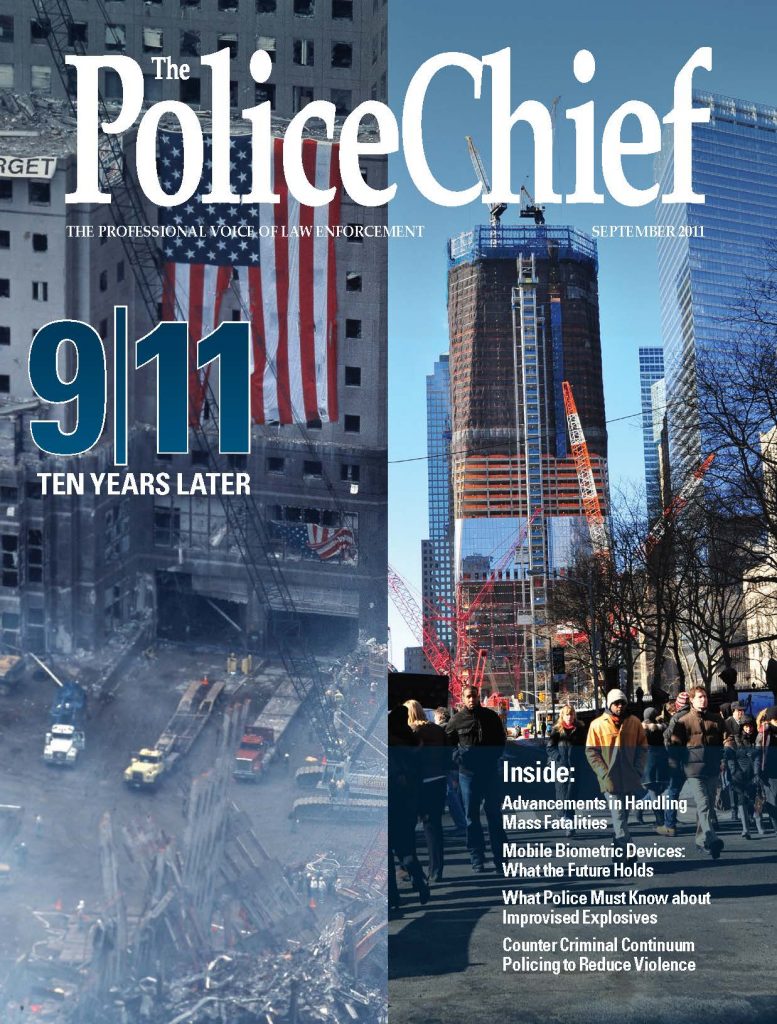
September 2011
Guest Editors: Jim McMahon, IACP, Kevin Lothridge, National Forensic Science Technology Center, Bill Coté, National Forensic Science Technology Center, Jamie Fox, National Forensic Science Technology Center
Since 9/11, terrorists have targeted New York City 13 times with plots against numerous city landmarks and locations. The most important lesson the New York City Police has learned during the past 10 years is the most obvious one: New York City, the world’s financial and communication capital, remains in the crosshairs of global terrorism. The threat of terrorism today is extremely complex. It is homegrown, and it is international. Law enforcement must guard against it.
Articles
-
10 Years after 9/11: Lessons Learned by the New York City Police Department
Since 9/11, terrorists have targeted New York City 13 times with plots against the New York Stock Exchange, Citigroup headquarters, the Brooklyn Bridge, John F. Kennedy International Airport, Times Sq... -
Handling Mass Fatalities: Advancements since 9/11 by the Office of the Chief Medical Examiner’s World Trade Center Identification Unit
Missing persons and unidentified human remains are a tremendous challenge to state and local law enforcement agencies. In 2007, a National Institute of Justice study estimated that as many as 40,000 c... -
Counter Criminal Continuum (C3) Policing in Springfield, Massachusetts: A Collaborative Effort between City and State Police to Reduce Gang Violence
The city of Springfield, Massachusetts, with a population of 153,060, is ranked the 12th most dangerous city in America. The North End section of Springfield has seen crime and gang violence increase ... -
Mobile Biometric Devices: What the Future Holds
Mobile biometric devices are providing benefits to law enforcement and homeland security field agents who use biometric collection to identify people during field operations in near real time. The use... -
Shining a Forensic Light on the Warfight
Since 2004, the Department of Defense (DOD) has been using forensic science tools on the battlefield. Traditional law enforcement techniques are being used to attack improvised explosive device (IED) ... -
What Law Enforcement Needs to Know about Improvised Explosives
On February 22, 2010, terrorist Najibullah Zazi pled guilty to conspiring to use weapons of mass destruction, conspiring to commit murder in a foreign country, and providing material support to a fore... -
The Arizona National Park Service Unit: Applying Advanced Investigative Science to Protecting the Nation’s Natural Treasures
The job requires visits to places where the terrain is steep and rocky, with narrow footpaths used to smuggle people and drugs. Individuals employed here experience the extremes of nature; summer temp... -
Challenges of Emerging Technology: Beyond the Technology Itself
With the rapid evolution of various technologies, law enforcement leaders have found themselves barraged with a constant stream of innovative technology tools, all of which are designed to improve cri... -
Proposed IACP Constitutional Amendments
For the last 118 years, the IACP has strived to identify, serve, and address the needs of its membership and the law enforcement profession. Its success and stability in meeting this mission is a test...
Columns
- President's Message: 9/11: 10 Years Later
- Legislative Alert: IACP Supports Bill to Combat Child Pornography
- IACP Foundation: SELECT Scholarship Recipients Proudly Announced for 2011–2012 Academic Year
- Chief's Counsel: Exigent Circumstances: What Is That?
- From the Director: NCIS Uses New Techniques to Fight an Old Crime

